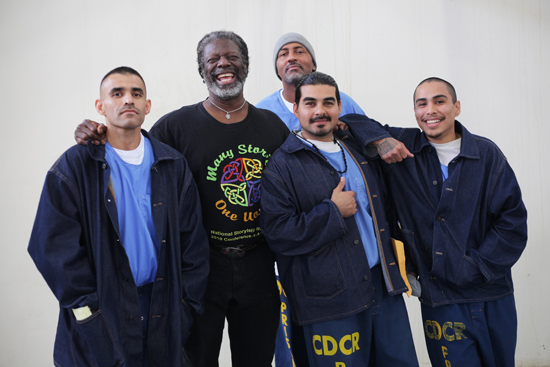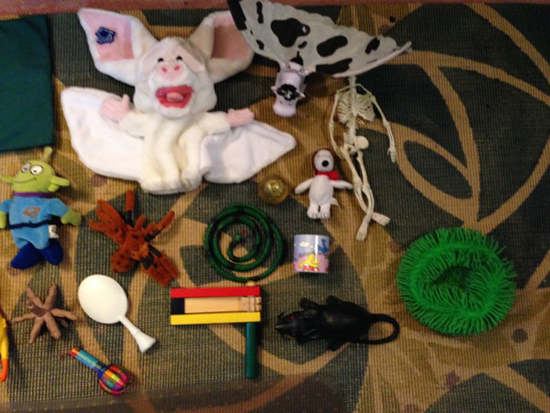
“To have once been a criminal is not the disgrace. To remain a criminal is the disgrace!”
-Malcolm X
Storytelling had always been an important part of my life via my mother, who read and told me stories and instilled in me the belief that as conscious human beings we had an obligation to stand up against injustice and to be of help to people whenever we could. In 1992, I became a professional storyteller. One of the people I met early on in my artistic career was performance artist Zoot. He told me about a program that he was involved in, Arts-in-Corrections (AIC), and I was intrigued. I remember thinking that I would love to be involved in such a program.
Fast forward to 2014. Two phone calls, one from Zoot, who is now the Executive Director of the Muckenthaler Cultural Center in Fullerton (The MUCK), the other from Quetzal Flores, Program Manager for the Alliance for California Traditional Arts (ACTA). I’d met Quetzal at an ACTA grant workshop he gave in Leimert Park in Los Angeles in 2013 and also presented a workshop for an ACTA-sponsored event later that same year. Both inquired whether I’d be interested in giving workshops for the resuscitation of the AIC program. Oh yeah!
On September 7, 2014, which happens to be my birthday, I drove up from my home in Southern California to the Central Valley to begin a two-week storytelling workshop commitment with the Muckenthaler AIC project working in five prisons: Kern Valley, Corcoran California State Prison (CSP), Corcoran Substance Abuse Treatment Facility (SATF), Valley State, and Pleasant Valley. I was the second of three artists involved in the Muckenthaler’s AIC project, following Guillermo Avila, who taught theatre workshops, and Zoot closed out the program by creating a theatrical production.
Just one week after finishing my “Muck” workshops, I began a second round of storytelling workshops, this time with ACTA. The ACTA AIC program lasted over thirteen weekly sessions and were all held at Corcoran CSP. I joined Quetzal and Cesar Castro, who gave son jarocho music workshops, and Omar Ramirez, who presented intensive drawing workshops. All of our workshops were presented simultaneously in the yard gym. Our first session was from 8:30-11:30 am, followed by an hour lunch break and an afternoon session from 12:30-3:30 pm. That seemed to be a daunting concept at first, but we made it work and it worked very well.
I had several of the same students that I’d met during the “Muck” AIC sessions and they were eager to work on more stories or further develop the ones they’d already begun. We were limited to a maximum of twelve per session and I was certain that I’d max out for both. On my first day with ACTA, I ended up with eighteen students between the two, three-hour classes.
Every Monday I’d leave my home at 4:30 am for the three hour drive to Corcoran. The second Monday we found that the previous week’s sign-up sheets had been lost, which resulted in a scramble for participants. Only a few of the previous week’s sign-ups would make it back to the classes due to their resolve to continue. Throughout the thirteen weeks, our classes would suddenly be cancelled due to lock downs, threats of violence to guards and staff, and the infamous fog. If the Valley fog was so thick that it impaired visibility, yard activity was shut down and inmates remained in their cells, for the most part. Apparently, there were priority activities that continued during fog alerts but our program did not have that status.

Despite such setbacks, great stories were developed and told. I used three primary tools in helping the participants develop their stories. First, I modeled primarily personal narratives with an occasional folk tale. I also used my Story Bag (see photo above), filled with a variety of wild and crazy items, such as a winged plastic cow, a ball of fingers, noisemakers, a rubber chicken, etc. Each inmate would pull something out of the bag and then tell a story that utilizing or was inspired by the object. As I told my students, once you can make up a story using this format, telling a personal story is easy. My third storytelling tool was to engage in “talk story,” where we sit and talk about whatever subjects come up—and invariably the stories happen.
RJ* told this story. He was in jail for a brief time and when he got out he found that his wife had had an affair with another man. At first it was not his intention to go after the man, but he got drunk one day and decided to go kick his ass. He knew the dude and knew where he lived. As he approached the man’s house he saw this scenario unfold before him. There was an ice cream truck, one of those that plays that funky “come get some ice cream” music, near the-soon-to-have-his butt-kicked’s house. The man came out of the house with his two kids. Neighborhood kids were gathered around the ice cream truck despite the fact that they had no money. The dude bought ice cream for his kids then pulled out a wad of money from his pocket and bought ice cream for every child there. RJ saw the good in this man and decided to let go of his anger. RJ told this story several times, each time refining it and adding more detail and nuance.
In the first session at Corcoran, Eric reached into my Story Bag and pulled out a mock book that contained a bookworm puppet. He created a story about the bookworm wanting to get out of the book and into the surrounding room, then his desire to get out of the room and into the world. Becoming a butterfly allowed him to go beyond the limitations of his confinement and to expand his consciousness and awareness. The butterfly died, eaten by an eagle, but he was happy to have experienced life beyond that book and the room.
Leslie had serious anger issues, which had landed him in prison for life. He was routinely in fights and would bash his fists against the walls of his cell. He was always angry. He met another lifer, an older gent, who practiced a unique art form. He would take strips of paper, make tiny beads, then use those beads to make art. Leslie was intrigued. He’d wanted to do some kind of art but hadn’t found anything that resonated with him. So he asked the old gent to teach him, and he agreed, with one condition. Leslie had to stop drinking for one year. Leslie’s response was, “Screw you!” And he didn’t say screw. But the thought of learning this art kept gnawing at him and he eventually agreed and immersed himself in learning the art form. He noticed that he was no longer bashing his fists against the walls of his cell anymore. Nor was he getting as angry, staying angry, or getting into as many fights. He wrote a letter of apology to the person he’d attacked that lead to him being incarcerated. He began to meditate. Ain’t that a trip!

Pajaro grew up in Mexico. As a kid he used to build traps to catch birds and for a long time; it was his favorite pastime. Whenever he approached the cages with the captured birds, he always observed the birds frantically pacing back and forth trying to get out. He found this amusing. Then he went to prison. One day, he was placed in solitary confinement, began pacing back and forth in the cell, and he remembered those birds. He ended his story saying that he never wanted to encage anything ever again.
WP was very frustrated. He’d been in the prison system for over twenty years— since he was a teenager, but there’s a chance that he’ll get out. He wants to get out in the worse way but he feels that he is still being defined by what he’d done all those years ago when he was a cocky, hardheaded gangbanger. During his storytelling time he would talk about his angst, not really telling a story, but venting his frustrations.
I’d told the inmates that everyone has at least one story that they need to be able to tell and part of my mission was to help them to find and articulate those stories. During one of our Talk Story sessions, WP recounted his relationship with a Corrections Officer (Mr. C) who’d known him almost from the beginning of his incarceration and who saw the good in him. He counseled WP, encouraging him to stop being such a knucklehead, which he did eventually. On a couple of occasions, WP was transferred to another facility only to find Mr. C was also there. He found out that Mr. C would tell the other officers, “WP is a good guy.” On one occasion, Mr. C began a “Scared Straight” type of program (minus the scared), and he asked WP to be a part of it. WP spoke to high school students about the stupid things he’d done that had landed him in prison and painted a picture of what prison life was like. His presentations were well received. This was that story!
What I found wonderfully amazing was the peace and contentment that shone in the men’s faces as they shared their stories. WP vented his frustration at still being defined for actions he’d done over twenty years ago, his rage overpowering his telling. But once he’d found his story, his delivery was calm and reflective. Now he had a story that could be heard. In our last session, two videographer/photographers came, interviewed and photographed our students. There had been concern that the inmates would not want to be a party to this, but they all signed on.
As much as I love telling stories, helping someone else find their stories is a phenomenal feeling. Most of the inmates didn’t really get storytelling at first. In their minds, storytelling only meant kiddy tales, lies, or telling jokes. But at some point they’d finally get and it was akin to discovering that they had a super power. Through the ancient art of storytelling, they could communicate their thoughts, their hopes, their feelings. God, I love my job!
* These stories are listed in no particular order. The names or initials used have no relation to the inmate’s real names.

